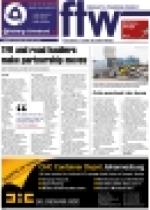Transnet Freight Rail
is making significant
strides in providing
customers with a reliable
and predictable transport
service, according to
executive manager:
intermodal business unit,
Wiseman Madinane.
Speaking exclusively
to FTW editor Joy Orlek,
he painted a picture
of a forward-thinking
organisation with one
overarching objective – to
decrease the unacceptably
high logistics costs for
South African shippers.
FTW: Have you achieved
the level of reliability
that shippers demand –
particularly on the Durban-
Gauteng (Natcor) corridor?
TFR: The Natal corridor
has stabilised immensely.
We have continued to shut
down for 10 days every year
in order to do maintenance
that we can’t do with trains
running. This has happened
every year around the same
time – July/August – and
we spend around R112m
during that 10-day period.
We will continue with this
maintenance – at least for
the next five years – or until
we feel we have done as
much as we can to stabilise
the corridor.
With the stable rail line
we’ve reduced transit times
for containers from vessel
discharge at the port to
available at City Deep from
just under 120 hours to
below 80 hours.
FTW: Are insufficient
resources still an issue?
TFR: We have managed
to stabilise our resources
even though
we haven’t
yet taken
delivery of
any of the new
locomotives
on the Natcor
– we’ve been
spending
money on
maintaining
our
locomotives.
We have
however
brought on
new wagons
to increase
our f leet and
create capacity.
We’ve also invested in
new generation telemeters
– equipment that alerts
the driver to problems like
braking or loss of a load. We
had a huge problem with the
failure of those units without
which no train can depart.
It’s a safety imperative.
FTW: What progress
has been made in port/rail
integration?
TFR: The Group has
rolled out a Transnet Value
Chain Coordination (TVCC)
programme to force the
integration of various
operating divisions. This
has helped to
ensure that
Transnet Port
Terminals
(TPT) and
TFR start
talking. We
previously
functioned
as separate
organisations
and this has
forced us to
start working
together.
Once a
train departs
Durban it will
be here 22
hours later. The problem is
to get it out of the ports into
the main line and also to get
it out of the train into the
terminal to make it available
to the customer. If you
take 22 hours out of 78 that
demonstrates how much time
is spent on either side of the
main line – and that’s what
we’re trying to shrink.
Port/rail coordination is
helping us to resolve issues
as Transnet and that helps
us to resolve them far more
quickly.
FTW: Have you achieved
the container volume growth
you were hoping for?
TFR: Container volumes
grew nicely until last year –
but that has a lot to do with
the economy. Imports have
dropped because of the weak
rand, and commodity prices
have discouraged exports.
The by-products of chrome
and manganese – known
as lumpies – can only be
transported in containers
and that’s going very well.
On domestic export
products we haven’t seen
growth in the past 18 months
purely because of the prices
of commodities and the rand/
dollar exchange rate.
FTW: Are you able to
maintain a scheduled service
timetable?
TFR: The whole of TFR
runs on an integrated train
plan which is a scheduled
railway model. It’s managed
by the national command
centre which monitors and
tracks every train on the
network. Each business
unit has its own satellite
operation centres which
monitor their own trains and
manage the deviations. On
the Natcor line the on-time
departure is now sitting
at 90%. On time arrival
is still struggling – we are
averaging 50% because of
the delays caused by crewing
or other failures. This will
be addressed as our assets
improve.
We also manage train
utilisation. If you’re only
using 40 wagons on a
50-wagon train you’re not
realising the full revenue. We
monitor that per train and
we also monitor the Train
Data Unit (TDU) which
manages the crew and the
asset itself.
On container trains
that’s gone from zero
utilisation to 80% and we’re
targeting 95%. Without that
information you don’t know
the utilisation of the train
– arrival, departure, stops
along the way etc. To enforce
this we won’t allow a train to
enter the main line unless it has
a TDU registered.
INSERT & CAPTION
We have managed
to stabilise our
resources even
though we haven’t
yet taken delivery
of any of the new
locomotives on the
Natcor.
– Wiseman Madinane
TFR achieves predictability objective
16 Oct 2015 - by Staff reporter
0 Comments
FTW - 16 Oct 15

16 Oct 2015
16 Oct 2015
16 Oct 2015
16 Oct 2015
16 Oct 2015
16 Oct 2015
16 Oct 2015
16 Oct 2015
16 Oct 2015
16 Oct 2015
Border Beat
Featured Jobs
New
New
New
New
